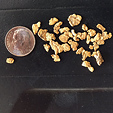All Articles
Legislative and Regulatory Update
April 2000 by Scott Harn
• Babbitt Wants Another 4 Million AcresDenver, CO (AP)—Interior Secretary Bruce Babbitt unveiled a program aimed at restricting another 4 million acres of open space across the West.
Part of the Clinton administration's plan to protect more federal land before leaving office, the new system will be called the National Landscape Monuments. Babbitt said the new monuments won't be set up for large numbers of visitors. In fact, they will have no visitor centers at all.
With the West becoming more urban, Babbitt said, the country needs to do more than just "see an Indian ruin and make a park or monument on 40 acres."
The BLM's territory isn't considered as glamorous or distinctive as what the Park Service has, and Babbitt has often battled with the BLM over bureau policies that favor mining and logging. Babbitt said he wants to give the agency a new role in preservation. "The nation's largest land management agency ought to be induced to have a sense of pride," Babbitt said. .
Tina Arapkiles, the Sierra Club's southwest regional representative, praised the announcement, saying it would shift the BLM from its traditional mining and logging mentality.
The federal government already owns the land being considered for landscape monument status, though some holdings might be purchased as well. The areas under consideration include the Santa Rosa Mountains near Palm Springs and the Carrizo Plain in the San Joaquin Valley near Santa Barbara.
"Some of the property...deserves the protection of monument status irrespective of the agency that man ages it," said Tom Kiernan of the National Parks Conservation Association in Washington, D.C. He continued, "I do have a fundamental concern that BLM doesn't now have the management policies and staffing and culture to manage these more sensitive lands. It is going to require scientific skills and staffing,"
Editor's Note: See Guest Editorial, "President's Land Plan Implements Unratified Treaty" for commentary.
• County Ruled Unfair in Mineral Valuations
The Nebraska Supreme Court ruled that Cass County, in Lincoln, Nebraska, was unfairly calculating the value of land for for tax purposes based on minerals that were being mined on several pieces of property.
In two cases, Cass County tried to assess property taxes based on the land and the minerals underground. The Nebraska Supreme Court ruled that other land in the area was not treated in the same way.
The cases involved several parcels of land owned by Ash Grove Cement Co. and Lyman-Richey Sand & Gravel Corp., which mine gravel and limestone on the property.
An outside appraiser, Patrick Shulte, was hired by the county. He valued four parcels of land owned by Ash Grove at $1.8 million and the minerals below ground at $826,500. Three parcels of land owned by Lyman-Richey were valued at $323,000 and the minerals below ground at $241,000.
The high court threw out the valuations placed on the minerals because the county violated the constitutional requirement that property be taxed uniformly.
"In Schulte's deposition, he admitted that there were properties in Cass County containing mineral interests that were not included in his appraisal report," wrote Judge Lindsey Miller-Lerman. "Furthermore, Schulte indicated that his appraisal report appraised properties, if those neighboring properties were not owned or leased by mining companies."
• Public Comment Period for Clean Water Action Plan
The President's Clean Water Action Plan announces the intention of the Departments of Agriculture and the Interior to develop a unified Federal policy on watershed management in consultation with other Federal agencies, States, Tribes, and interested stakeholders. This policy would provide a framework for a watershed approach to Federal land and resource management activities. Comments need to be submitted by April 24, 2000.
BLM's web-site states that regional meetings were held in March to allow for public comment. It's interesting to note that not one of these meetings was located in Alaska, Arizona, California, Idaho, Montana, Nevada, Washington, or Wyoming. The BLM web-site states:
The policy proposes that Federal agencies take a 'watershed approach' to Federal land and resource management. A watershed approach focuses Federal efforts on identifying high priority watersheds to maximize the potential for overall improvement and protection of these watersheds. The policy emphasizes:
• Assessing the function and conditions of watersheds;
• Incorporating watershed goals in planning;
• Enhancing pollution prevention and meeting our Clean Water Act responsibility;
• Identifying priority watersheds to focus budgetary and other resources;
• Monitoring and restoring watersheds; and
• Expanding collaboration with others.
For further information, go to: http://www.blm.gov/nhp/index.htm

Melman on Gold & Silver
The focus of attention by the financial media during past month has shifted considerably away from the international political and terrorist outlook and turned clearly toward important developments as they appear likely to affect the outlook for the US and worldwide economies in the coming year.
Nevada Looks to Tourism to Fill Mining's Gap
Lt. Gov. Lorraine Hunt and the Nevada Commission on Tourism have agreed to seek an unspecified amount of marketing funds to boost tourism in the Ely, Nevada area in the wake of a mine closing.
The Bawl Mill
• Texas government has more plot twists than the TV series “Dallas”
Melman on Gold & Silver
Two potentially important Canadian projects, which could have produced revenues in the billions and jobs in the tens of thousands, have now been officially abandoned and the reasons offered by both relate to the economic impossibility of successfully negotiating all the regulatory obstacles that have been presented.
Key to Successful Prospecting: Confidence
 The one undeniable truth in prospecting is that the more time you spend in the field, the more gold you will find. Here are a few keys I use to help build my confidence.
The one undeniable truth in prospecting is that the more time you spend in the field, the more gold you will find. Here are a few keys I use to help build my confidence.
Exploring A Historic Lode Mine
Climbing up the debris, I pointed my flashlight up a shaft ascending straight up as far as my light would shine. It was the stope of the pay shoot leading to the old tunnel above!
Subscription Required:
The Bawl Mill
• USFS Chief in Nevada
• Uranium Miners May Be Compensated
• Dairy Farmer Hits Pay Dirt
• Canyon Resources in Battle in Montana
• Guest Editorial—President's Land Plan Implements Unratified Treaty
• Gold in Washington
• Picks & Pans: Tips for Nuggestshooting—How to Increase Your Gold Finds (Part I)
• Alaska Mining Industry Sees 5% Growth in 1999
• El Paso Mountains Mining History
• Platinum Prices Could Spur Wyoming Rush
• The Wooden Cross
• Mining Hall of Fame Seeks Rhymes of the Mines
• Collecting Garnets in Wyoming
• A Trip to Tucson 2000
• McCaw School of MInes Dedicates Phase II
• Melman on Gold & Silver
• Mining Stock Quotes and Mineral & Metal Prices
Free:








